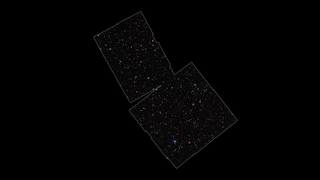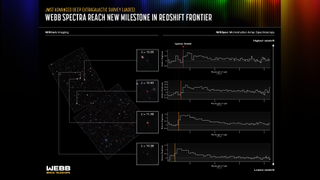Confirmed! James Webb Space Telescope has bagged the oldest known galaxies
The galaxies formed when the universe was only 350 million years old, just 2% of its current age.

Astronomers confirmed that four ancient galaxies detected by the James Webb Space Telescope in the early months of its operations are the oldest scientists have ever seen and nearly as old as the universe itself.
The galaxies were among hundreds of promising stellar conglomerations found in images from the Near Infrared Camera (NIRCam) aboard the James Webb Space Telescope (Webb or JWST). But scientists were only able to confirm that these ancient objects really were as old as they appeared after they looked at them in detail with the Near Infrared Spectrograph, which revealed their chemical composition and determined how fast these galaxies are moving away from Webb.
The astronomers now know that light from the four galaxies took more than 13.4 billion years to reach Webb. More precisely, the telescope sees the galaxies as they looked only 350 million years after the Big Bang, when the universe was only 2% of its current age, although the galaxies must have started to form even earlier.
Observing such young stellar families is exactly what Webb was built for, and scientists are excited that it began delivering such fascinating results so early in its operations.
"These [galaxies] are well beyond what we could have imagined finding before JWST," Brant Robertson, an astrophysicist at the University California Santa Cruz and one of the researchers involved in the observations, said in a statement. "With JWST, for the first time we can now find such distant galaxies and then confirm spectroscopically that they really are that far away."
To confirm that the galaxies really were as old as they seemed, astronomers had to obtain precise estimates of the so-called redshift from NIRSpec's data. Redshift makes objects that are moving farther away from us appear redder as a result of the expansion of the universe, which stretches the light emitted by distant stars and galaxies into longer, redder wavelengths of the light spectrum.
Get the Space.com Newsletter
Breaking space news, the latest updates on rocket launches, skywatching events and more!
The most distant of the galaxies detected by Webb displayed a redshift of 13.2, which corresponds to an age of about 13.5 billion years — the highest ever measured for any galaxy.
"At redshift 13, the universe is only about 325 million years old," Robertson said.
The observations were conducted as part of the JWST Advanced Deep Extragalactic Survey (JADES) project, which uses NIRCam and NIRSpec to study the early universe in ways that were impossible before.

An international collaboration of more than 80 astronomers, JADES is only at the beginning of its endeavor. Next, the astronomers want to look at individual stars in those galaxies, some of which may have been born up to 100 million years earlier than the age at which they are seen by Webb.
"With these measurements, we can know the intrinsic brightness of the galaxies and figure out how many stars they have," Robertson said. "Now we can start to really pick apart how galaxies are put together over time."
The observations match what astronomers expected based on existing galaxy formation models, Robertson added.
In the NIRCam observations, the team also identified galaxies that appear even older than those now confirmed, but the ages of those have not yet been verified by the more accurate spectroscopic measurements from NIRSpec.
The new findings will be presented on Monday (Dec. 12) at a Space Telescope Science Institute conference in Baltimore.
Follow Tereza Pultarova on Twitter @TerezaPultarova. Follow us on Twitter @Spacedotcom and on Facebook.
Join our Space Forums to keep talking space on the latest missions, night sky and more! And if you have a news tip, correction or comment, let us know at: community@space.com.

Tereza is a London-based science and technology journalist, aspiring fiction writer and amateur gymnast. Originally from Prague, the Czech Republic, she spent the first seven years of her career working as a reporter, script-writer and presenter for various TV programmes of the Czech Public Service Television. She later took a career break to pursue further education and added a Master's in Science from the International Space University, France, to her Bachelor's in Journalism and Master's in Cultural Anthropology from Prague's Charles University. She worked as a reporter at the Engineering and Technology magazine, freelanced for a range of publications including Live Science, Space.com, Professional Engineering, Via Satellite and Space News and served as a maternity cover science editor at the European Space Agency.
-
Unclear Engineer This article says "The observations match what astronomers expected based on existing galaxy formation models."Reply
So, how old does a galaxy have to be for it to be "unexpected"?
And, how long would an exposure need to be for Webb to detect such a galaxy? -
rod My notes. Using cosmology calculators can check figures here in the report. z=13.2, look back time distance = 13.396 Gyr, age of universe at z=13.2, 0.326 Gyr, comoving radial distance = 33.386 Gly distance. Using H0=69 km/s/Mpc, 4D space expanding ~ 2.36 x c velocity. The universe radius for z=13.2 when the galaxy first appeared, about 2.35 Gly so the diameter of the early universe then about 4.7 Gly compared to present, about 93 billion light years (CMBR z=1100). Indeed, 4D space is expanding very fast in the BB cosmology.Reply
LAMBDA - Links to Calculators (nasa.gov) -
Turtle So as the light travels long distances it red shifts, from a high frequency toReply
a lower one, even until it turns into cosmic microwave background. This is because it is being stretched?
But red light or microwaves are of lower wattage than x-rays or blue light.
Where does the lost energy go from the light as it is lowered in frequency? As space is stretching as the light goes through it the light is losing energy.
What if for some billions of years the light just was reflected back and forth
between two perfect mirrors some minor distance apart? Would it still shift?
Thanks -
billslugg The shifting of the wavelength is only seen in your stationary reference frame. To the observer on the distant star, the star gives off nothing but yellow light in all directions.Reply
From your perspective, the star is moving away from you at a high velocity. Light coming towards you is red shifted, light going away from you is blue shifted. The loss of energy in the red photons is exactly balanced by the energy gain by the blue photons.
What if the only light emitted was in a beam straight backwards? In that case the loss of energy of the red photons would be accompanied by a gain in kinetic energy of the star.
Kinetic energy is not conserved when going from one reference frame to another. In your rest frame, nothing has any kinetic energy except a flying bullet. From the reference frame of the bullet, it is at rest with zero kinetic energy and you and the entire Earth is going at bullet speed. -
Unclear Engineer Bill, I think you mis-posted regarding "light going away from you is blue shifted", in that you would not see "light going away from you". It is light coming toward you from the direction you are traveling towards that is blue shifted. In expanding space, light coming toward you from a distant object looks red shifted, and light from that object that has passed you will continue to be red shifted such that a distant mirror that reflects some of it back toward you will show that additional red shift. (The reflected light would be redshifted going to the mirror and redshifted even more while traveling from the mirror back to you.)Reply
The OP seemed to be thinking more about the density of energy in space as light traveling in that space is stretched by the expansion of space. Yes, the light received when red shifted is at lower energy, but presumably that light would be shining onto something for longer period of time, so the total energy transferred would be the question to answer. (I don't have the time to do the math, right now.)
The part of the OP that asks about how light shining back and forth between mirrors that are not far apart being affected by the expansion of space is a much more complex to address. Do we assume that the mirrors and the distance between them are somehow unaffected by the expansion of the space around them, or do we assume that the mirrors themselves and the distance between them is expanding like everything else? -
rod Are there direct observation tests for 4D space expanding in our solar system?Reply
Consider H0 = 67 km/s/Mpc. That value can be converted to c.g.s. units. ~ 2.17 x 10^-18 cm/s/cm. If I use H0=73 km/s/Mpc, ~ 2.37 x 10^-18 cm/s/cm for 4D space expansion rate. On Earth, do we see this tiny 4D space expansion taking place?
My post #3 calls attention to different distances and universe sizes as well as ages used in GR math to explain the redshift of 13.2. Many of those distances and ages are not directly verifiable like the Galilean moons moving around Jupiter, for example. I know I cannot see today a universe somewhat smaller than 5 billion light years diameter or the present universe size of some 93 billion light years in diameter. -
billslugg Unclear Engineer - My reference to light going away from you as being blue shifted was in the case of light being emitted on the far side of a star moving away from you. In the case of a high velocity star moving away from an observer, the light aimed back at the observer is red shifted, the light aimed in the direction of the star's travel is blue shifted. When accounting for the energy balance the two cancel out.Reply
Yes, the energy density is lower due to the red shift but the space is expanded thus the total energy remains the same.
Light passing between two mirrors whould appear red shifted when coming towards the observer and blue shifted when going away from the observer. -
Helio Doppler motion explains light shifts as a light source and viewer move through space relative to one another. GR (General Relativity) addresses the shift of light as it travels through expanding space, so expansion “stretches” the light, and always toward red.Reply
Where this energy goes likely requires a great understanding of GR, but I’m inclined to think there is more mystery to this.
Although a photon packet of light does take longer to impact something (so dimmer), I’m confident the total energy is less by the loss in energy due to the cosmological redshift for each photon. -
Helio I finally got an answer to a gedaken experiment where a mirror is placed on an inelastic pole, and at an extreme distance (a billion lyrs.) A green laser reflects off of it and it shows redshift upon its return, according to physicists.Reply
iPhone -
Turtle Thank you Hellio,Reply
So light traveling through space is red shifted (according to physicists) and its total energy is lowered. Where does this energy go?
Of course ( I heard this) the high vacuum of space is never considered to be empty, not really. There are the quantum fluctuations. Other than light there are other energies that radiate out there. Magnetic fields and gravity which have no particular frequency to them. Do they lose energy and get absorbed?
